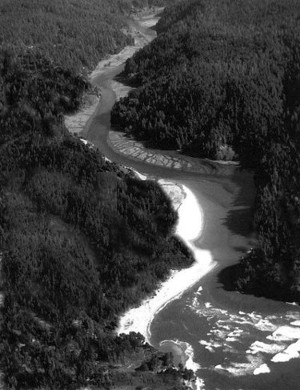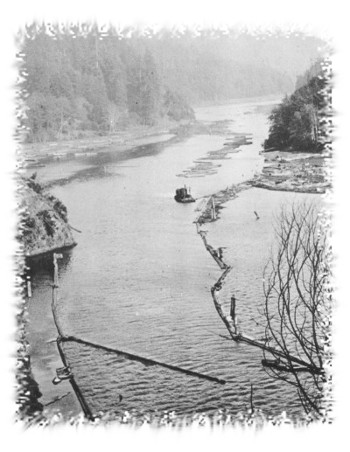
Compared to
Mark Twain's mighty MIssissippi, Big River is not big at
all. The Big River watershed
is about 181 square miles; the Mississippi's, 1.2 million
square miles. Mark Twain knew, however, that a river, especially
in 19th century America, was more than just meandering water.
Its social impact could not be measured in river miles or
watershed size. A river was a wild stream of dreams and
destinies, of stories waiting to unfold. For the logging
pioneers of Mendocino County, Big River became their dream
and their destiny—the entrance to the forest by the
sea. With the help of Big River, these individuals pitted
themselves against both the forest giants and the treacherous
sea. They tackled the earth's biggest trees with only hand
axes and saws, often taking a week or more to fell one tree.
Oxen, yoked together in teams of eight or twelve, dragged
the immense logs to the river's edge, where they were collected
behind splash dams, and then floated downstream to a sawmill.
From there the cut lumber was loaded onto schooners lying
just off the jagged Mendocino coast. The primeval forest,
that must have seemed at first so impregnable, stretching
out further than eye could see or eagle could fly, fell
one tree at a time to human determination. Only individual
old growth trees or groves, too inaccessible for the early
technology or judged undesirable for milling, remain—scattered
about the shadowlands, lonely reminders of a giant forest
that once touched the sea.
The pioneer
lumbermen of Mendocino County never heard of "the American
Dream." That term was coined by an American historian,
James Adams, in 1931, ironically during the Great Depression
when many Americans, out of work and out of luck, thought
the dream had died. The Big River lumbermen, however, embodied
the very essence of the American dream, namely, that with
hard work, determination, and audacity, anyone could achieve
wealth. Wealth represented freedom—freedom from want,
freedom to have more, freedom from the past. Like the immigrants
before them, they were part of an inexorable push of Americans
to expand, to tame, to build, and to succeed.
 Men
like Jerome Ford and Edwards Williams, the entrepreneurs
or adventurers who started logging operations at Big River,
as well as all those who came after them in Mendocino County
for the next 100 years, were so successful that they almost
destroyed what they first admired. The National Park Service
estimates that about 3% of the ancient redwood forest remains,
while most coastal redwoods, except for those in state and
national parks, are second and third growth. "Why did
they take it all?" That question nags many of us. One
answer is that the early lumbermen in northern California
could not have known how old the redwood trees were that
their sweat and ingenuity toppled. Archaeological tree-ring
dating started about 1917 with the work of an astronomer,
Andrew Douglass, although the practice took several decades
to be widespread. Before that, we were dependent on human
memory. In the 19th century, a Philadelphia merchant might
point to a spreading oak tree in the court house square
and say, "Son, your grandfather told me this tree was
here when the Declaration of Independence was signed in
1776." Jerome Ford arrived at Big River to lay plans
for the first sawmill in Mendocino County on June 16, 1852—just
76 years after the signing of the Declaration of Independence.
How could he know that the trees he stared at in disbelief
were 500, 1500, or even more than 2000 years old? Even with
the help of science, our minds have difficulty comprehending
the life span of an ancient redwood. Would the loggers have
stayed the swing of their axes if they had known the age
of the redwood forest? Not likely, any more than they would
have stayed their picks to let the gold lie quietly beneath
the earth. Today there are many get-rich dreams to latch
onto, including the workingman's favorite—winning
the lottery. In the 19th century, the land and its resources
were the ready means to wealth.
Men
like Jerome Ford and Edwards Williams, the entrepreneurs
or adventurers who started logging operations at Big River,
as well as all those who came after them in Mendocino County
for the next 100 years, were so successful that they almost
destroyed what they first admired. The National Park Service
estimates that about 3% of the ancient redwood forest remains,
while most coastal redwoods, except for those in state and
national parks, are second and third growth. "Why did
they take it all?" That question nags many of us. One
answer is that the early lumbermen in northern California
could not have known how old the redwood trees were that
their sweat and ingenuity toppled. Archaeological tree-ring
dating started about 1917 with the work of an astronomer,
Andrew Douglass, although the practice took several decades
to be widespread. Before that, we were dependent on human
memory. In the 19th century, a Philadelphia merchant might
point to a spreading oak tree in the court house square
and say, "Son, your grandfather told me this tree was
here when the Declaration of Independence was signed in
1776." Jerome Ford arrived at Big River to lay plans
for the first sawmill in Mendocino County on June 16, 1852—just
76 years after the signing of the Declaration of Independence.
How could he know that the trees he stared at in disbelief
were 500, 1500, or even more than 2000 years old? Even with
the help of science, our minds have difficulty comprehending
the life span of an ancient redwood. Would the loggers have
stayed the swing of their axes if they had known the age
of the redwood forest? Not likely, any more than they would
have stayed their picks to let the gold lie quietly beneath
the earth. Today there are many get-rich dreams to latch
onto, including the workingman's favorite—winning
the lottery. In the 19th century, the land and its resources
were the ready means to wealth.
We also cannot
ignore the fact that, while there were individuals in the
early 19th century who wrote about the beauties of nature,
there was not a general environmental consciousness. George
Stewart, often called the Father of Sequoia National Park,
wrote editorials as early as 1876 about the destruction
of the giant sequoias, trees in the same botanical family
as the coastal redwoods. As a result, the U.S. government
created Sequoia, Yosemite, and General Grant national parks
in 1890. John Muir matured his conservation philosophy while
working in Yosemite Valley from 1869-1871. Muir, in fact,
operated a small sawmill near Yosemite Falls to lumber wind-felled
trees. Not until 1892, however, did he become one of the
founding members of the Sierra Club to save America's last
wilderness. Around 1903, the Sempervirens Club managed to
acquire 3800 acres of coastal redwoods at Big Basin near
Santa Cruz, California and have the area declared a park.
As the influence of such groups grew and environmental concerns
became a movement, more pressure was put on government agencies
and lumber companies to act responsibly about the remaining
redwood old growth, but by then America was well into the
20th century and most of the old growth redwood was depleted.
Deforestation,
as reports from the U.N. and environmental watch groups
remind us, is a global issue. This was also true in 19th
century America. In his book, A Forest Journey,
John Perlin observes that "forests always recede as
civilizations develop and grow." For over 5,000 years,
wood was the primary material for housing, fuel, furniture,
ships, bridges, carriages, wagons, carts, mine shafts, waterwheels,
spears, tool handles, wine barrels—the list goes on
and on. As their own forests receded, England and Europe
looked to the "New World" to supply their need
for wood. In the 19th century, while we were shipping lumber
to England, West Indies, and other places, Americans placed
their own considerable pressures on our forests as our population
rapidly grew. According to the U.S. Census Bureau, there
were about 3.9 million people in U.S. states and territories
in 1790; 7.2 million in 1810; 23.1 million in 1850; and
50.1 in 1880. Many Americans saw the forest as standing
in the way of houses, villages, and agriculture. Their goal
was not saving or managing a forest but pushing it further
and further back. Tench Coxe, an early American economist
and associate of Alexander Hamilton, wrote in the preface
to the 1810 U.S. census that "our forests [en]cumber
a rich soil, a hundred or two hundred miles from the sea,
and prevent its cultivation" (Perlin, 360). He advised
Americans to reduce the forests to cabinets, furniture,
gun stocks, casks, shingles, charcoal, and fuel. The forests
east of the Mississippi and north of the Ohio were the first
to recede. Frederick Marryat, a 19th century English novelist,
observed in his travels of upstate New York that "the
giants of the forest, which had for so many centuries reared
their heads undisturbed...now lay prostrate before civilization"
(Perlin, 356). In early America, it was not simply the redwoods
that grew to large size. Perlin cites reports from the early
1800s of oak that was over 140 ft high and 6 ft in diameter,
walnut trees 7 ft in diameter, and sycamore almost 13 feet
in diameter (Perlin, 325-6).. The Eastern states had supplied
high-priced lumber to San Francisco merchants as population
and construction exploded there following the Gold Rush.
The discovery of the redwood forests of northern California
opened a new, less expensive supply of wood for Californians.
Today Mendocino
Redwood Company owns about 30% of the Big River watershed,
near its headwaters. This amounts to 34,114 acres of which
less than 500 acres have scattered old growth trees. The
next largest owner of the Big River watershed is Jackson
Demonstration State Forest with 22,714 acres. The top photo
shows Big River snaking toward the sea, the ocean breakers
pushing back its spillage. The first sawmill in Mendocino
County was built on the Mendocino headlands, rising about
95 ft above the ocean—the site just visible in the
bottom center of the photo. A later saw mill was built on
the river flats, not far from the mouth of the river. This
photo was digitally manipulated to show how Big River might
have looked to the early lumbermen. Mouse over the photo
to see a more recent view. The bottom photo is a picture
of the steamer, "Big River," towing log rafts.